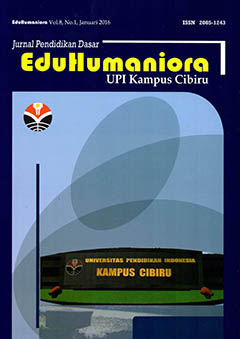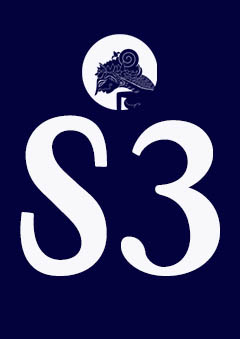DESAIN DIDAKTIS SOAL CERITA OPERASI HITUNG CAMPURAN UNTUK KELAS III SEKOLAH DASAR
Abstract
Abstract: This research based on the student’s learning obstacle of mixed operation of word problem. The purpose of the research is to explore student’s learning obstacle in order to plan didactic design of mathematics learning, especially in word problem matter that can be implemented in third grade students elementary school. The approach used in this research is the qualitative approach through the method of Didactical Design Research (DDR). Technique of collecting data uses documentation, interview, test and observation. The data was analyzed qualitatively for knowing student’s learning obstacle. The focus of the analysis is based on the theory of didactic situation, and the result of this analysis are used for the development of a didactic design hypothetic. The researcher makes pedagogic didactic anticipation based on identified learning obstacle. The didactic design was implemented in SDN 154 Purwodadi Tanjung Jabung Barat. The result of research showed that student’s ontogenical obstacle, didactical obstacle and epistimological obstacle in learning mixed operation of word problem. Based on the above findings, an expected alternative didactical design was composed to minimaze the obstacle that has been identified. From the research it can be concluded that by using this didactic design is one of the alternatives in learning the mixed operation of word problem in elementary school of class III found that learning obstacle can be reduced.
Keyword: Didactic design, word problem, mixed operation, learning obstacle.
Abstrak: Penelitian ini dilatarbelakangi oleh munculnya hambatan belajar (learning obstacle) siswa tentang soal cerita operasi hitung campuran. Tujuan penelitian ini adalah mengeksplorasi learning obstacle untuk merancang desain didaktis pembelajaran matematika soal cerita operasi hitung campuran yang dapat diterapkan di kelas III Sekolah Dasar. Pendekatan yang digunakan dalam penelitian ini adalah pendekatan kualitatif melalui metode DDR (Didactical Design Research). Pengumpulan data dilakukan dengan menggunakan teknik dokumentasi, wawancara, tes dan obervasi. Data dianalisis secara kualitatif untuk menemukan learning obstacle. Fokus analisis berdasarkan teori situasi didaktis, dan hasil analisis ini digunakan untuk pengembangan desain didaktis hipotetik. Peneliti menyusun antisipasi didaktis pedagogis berdasarkan learning obstacle yang telah teridentifikasi. Desain didaktis yang telah dirancang tersebut diujicobakan di SDN 154 Purwodadi Tanjung Jabung Barat. Hasil penelitian menunjukkan siswa mengalami ontogenical obstacle, didactical obstacle dan epistimological obstacle pada pembelajaran soal cerita operasi hitung campuran. Berdasarkan temuan diatas, disusunlah suatu desain didaktis alternatif yang diharapkan mampu mengatasi learning obstacle yang telah teridentifikasi. Dari hasil penelitian dapat disimpulkan bahwa penggunaan desain didaktis ini merupakan salah satu alternatif dalam pembelajaran soal cerita operasi hitung campuran di SD kelas III, sehingga learning obstacle siswa dapat dikurangi.
Kata Kunci: Desain didaktis, soal cerita, operasi hitung campuran, learning obstacle
Full Text:
PDFReferences
Abdurrahman, M. (1999). Pendidikan Bagi Anak Berkesulitan Belajar. Jakarta: Depdikbud & PT. Rineka Cipta.
Bailey, T. (2002). Taking The Problems Out of Word Problems. Teaching PreK–8, 32 (4), hlm. 60–61.
Brousseau, G. (2002). Theory of Didactical Situations in Mathematics. Dordrecht: Kluwer Academic Publishers.
Capstone, B & Fetrow, J. (2009). Word Problem in Math. 6th Grade Teacher. [Online]. http://files.eric.ed.gov/fulltext/ED506237.pdf.
Daroczy, G. dkk. (2015). Word Problems: A Review of Linguistic and Numerical Factors Contributing to Their Difficulty. Fontier in Psychology, 6 (348), hlm. 1-13. DOI: 10.3389/fpsyg.2015.00348. PMCID: PMC4381502
Karnasih, I. (2015). Analisis kesalahan Newman pada Soal Cerita Matematis (Newman’s Error Analysis in Mathematical Word Problems). Jurnal PARADIKMA, 8 (1), hlm. 37-51.
Kaselin, Sukestiyarno, & Waluya (2013). Kemampuan Komunikasi Matematis pada Pembelajaran Matematika dengan Strategi REACT Berbasis Etnomatematika. Unnes Journal of Mathematics Education Research. 2 (2), hlm. 121-127.
Kilpatrick, Swaford, J., & Indell, B. (2010). Adding It Up: Helping Children Learn Mathematics. Washington DC: National Academy Press.
Moleong, L.J. (2011). Metodologi Penelitian Kualitatif. Bandung: Remaja Rosdakarya.
Ng S. F., & Lee, K. (2005) How Primary Five Pupils Use the Model Method to Solve Word Problems. The Mathematics Educator, 9, (1), hlm. 60-83.
Polya (1945) How to Solve It. (2nd Edition). Princeton, NJ: Princeton University Press Raharjo, M., Ekawati, & Rudianto. (2009). Modul Matematika SD Program BERMUTU : Pembelajaran soal cerita di SD. Jakarta: Depdiknas.
Schley, D. R. & Fujita, K. (2014). Seeing the Math in the Story: On How Abstraction Promotes Performance on Mathematical Word Problems. Social Psychological and Personality Science,5(8), hlm. 953-961.
Sepeng, P. & Webb, P. (2012). Exploring Mathematical Discussion in Word Problem Solving. Pythagoras, 33 (1),hlm. 1-8. DOI: 10.4102/pythagoras.v33i1.60.
Sugiyono (2012). Metode Penelitian Pendidikan. Pendekatan kuantitatif, kualitatif & R&D. Bandung: Alfabeta.
Suharyanto, & Jacob, C. (2009). Matematika 3 (BSE). Jakarta: Pusat Perbukuan Depdiknas.
Suryadi, D. (2010). Menciptakan Proses Belajar Aktif: Kajian dari Sudut Pandang Teori Belajar dan Teori Didaktik. Bandung: Tidak diterbitkan.
Suryadi, D. (2013) Didactical Design Research (DDR) to Improve the Teaching of Mathematics. Ar East Journal Mathematical Education. 10(1), hlm. 91-107.
Verschaffel, L., Greer, B. & De Corte, E. (2000). Making Sense of Word Problems, Lisse, The Netherlands, Swets and Zeitlinger Publishers. ISBN 90 265 1628 2.
White, A.L (2010). Numeracy, Literacy and Newman’s Error Analysis. Journal of Science and Mathematics Education in Southeast Asia, 33 (2) hlm. 129 – 148.
DOI: https://doi.org/10.17509/eh.v8i1.5117
Refbacks
- There are currently no refbacks.
Copyright (c) 2017 Kampus Cibiru 2016
EduHumaniora: Jurnal Pendidikan Dasar
Published in collaboration Program Studi PGSD UPI Kampus Cibiru
and
HDPGSDI
This work is licensed under a Creative Commons Attribution-ShareAlike 4.0 International License.















